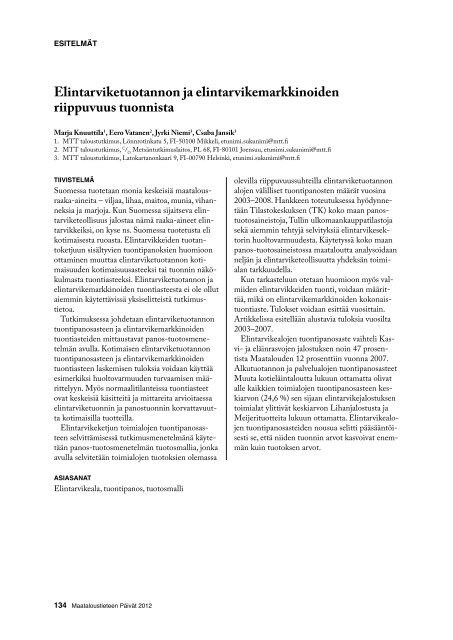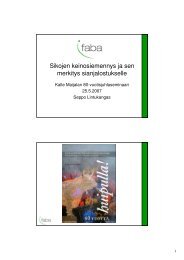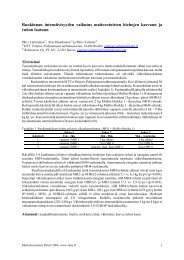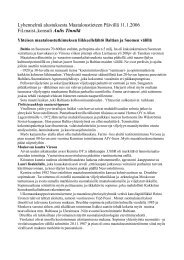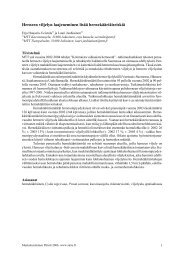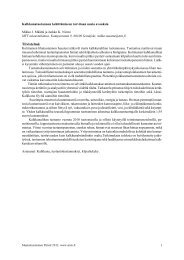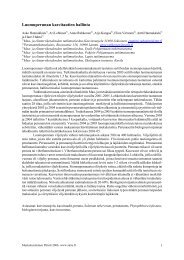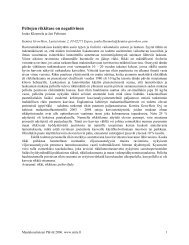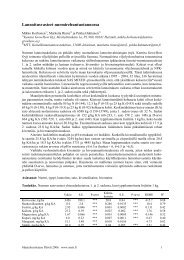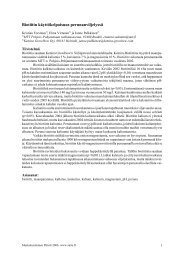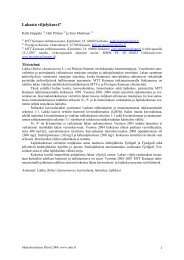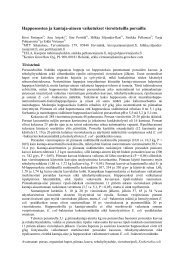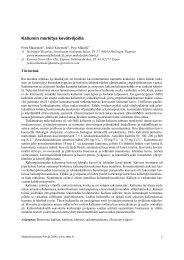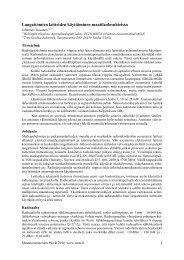Maataloustieteen Päivät 2012 - Suomen Maataloustieteellinen ...
Maataloustieteen Päivät 2012 - Suomen Maataloustieteellinen ...
Maataloustieteen Päivät 2012 - Suomen Maataloustieteellinen ...
Create successful ePaper yourself
Turn your PDF publications into a flip-book with our unique Google optimized e-Paper software.
ESITELMÄT<br />
Kansainvälistyvä elintarvikkeiden kauppa<br />
Elintarviketuotannon ja elintarvikemarkkinoiden<br />
riippuvuus tuonnista<br />
A measure of cereal market integration<br />
between Finland and European major countries<br />
Marja Knuuttila 1 , Eero Vatanen 2 , Jyrki Niemi 3 , Csaba Jansik 3<br />
1. MTT taloustutkimus, Lönnrotinkatu 5, FI-50100 Mikkeli, etunimi.sukunimi@mtt.fi<br />
2. MTT taloustutkimus, C / O<br />
Metsäntutkimuslaitos, PL 68, FI-80101 Joensuu, etunimi.sukunimi@mtt.fi<br />
3. MTT taloustutkimus, Latokartanonkaari 9, FI-00790 Helsinki, etunimi.sukunimi@mtt.fi<br />
Liu Xing 1 , Csaba Jansik 2 and Jyrki Niemi 3<br />
1. MTT Agrifood Research Finland, Economic Research, Helsinki, Finland, xing.liu@mtt.fi<br />
2. MTT Agrifood Research Finland, Economic Research, Helsinki, Finland, csaba.jansik@mtt.fi<br />
3. MTT Agrifood Research Finland, Economic Research, Helsinki, Finland, jyrki.niemi@mtt.fi<br />
TIIVISTELMÄ<br />
Suomessa tuotetaan monia keskeisiä maatalousraaka-aineita<br />
– viljaa, lihaa, maitoa, munia, vihanneksia<br />
ja marjoja. Kun Suomessa sijaitseva elintarviketeollisuus<br />
jalostaa nämä raaka-aineet elintarvikkeiksi,<br />
on kyse ns. Suomessa tuotetusta eli<br />
kotimaisesta ruoasta. Elintarvikkeiden tuotantoketjuun<br />
sisältyvien tuontipanoksien huomioon<br />
ottaminen muuttaa elintarviketuotannon kotimaisuuden<br />
kotimaisuusasteeksi tai tuonnin näkökulmasta<br />
tuontiasteeksi. Elintarviketuotannon ja<br />
elintarvikemarkkinoiden tuontiasteesta ei ole ollut<br />
aiemmin käytettävissä yksiselitteistä tutkimustietoa.<br />
Tutkimuksessa johdetaan elintarviketuotannon<br />
tuontipanosasteen ja elintarvikemarkkinoiden<br />
tuontiasteiden mittaustavat panos-tuotosmenetelmän<br />
avulla. Kotimaisen elintarviketuotannon<br />
tuontipanosasteen ja elintarvikemarkkinoiden<br />
tuontiasteen laskemisen tuloksia voidaan käyttää<br />
esimerkiksi huoltovarmuuden turvaamisen määrittelyyn.<br />
Myös normaalitilanteissa tuontiasteet<br />
ovat keskeisiä käsitteitä ja mittareita arvioitaessa<br />
elintarviketuonnin ja panostuonnin korvattavuutta<br />
kotimaisilla tuotteilla.<br />
Elintarvikeketjun toimialojen tuontipanosasteen<br />
selvittämisessä tutkimusmenetelmänä käytetään<br />
panos-tuotosmenetelmän tuotosmallia, jonka<br />
avulla selvitetään toimialojen tuotoksien olemassa<br />
ASIASANAT<br />
Elintarvikeala, tuontipanos, tuotosmalli<br />
olevilla riippuvuussuhteilla elintarviketuotannon<br />
alojen välilliset tuontipanosten määrät vuosina<br />
2003–2008. Hankkeen toteutuksessa hyödynnetään<br />
Tilastokeskuksen (TK) koko maan panostuotosaineistoja,<br />
Tullin ulkomaankauppatilastoja<br />
sekä aiemmin tehtyjä selvityksiä elintarvikesektorin<br />
huoltovarmuudesta. Käytetyssä koko maan<br />
panos-tuotosaineistossa maataloutta analysoidaan<br />
neljän ja elintarviketeollisuutta yhdeksän toimialan<br />
tarkkuudella.<br />
Kun tarkasteluun otetaan huomioon myös valmiiden<br />
elintarvikkeiden tuonti, voidaan määrittää,<br />
mikä on elintarvikemarkkinoiden kokonaistuontiaste.<br />
Tulokset voidaan esittää vuosittain.<br />
Artikkelissa esitellään alustavia tuloksia vuosilta<br />
2003–2007.<br />
Elintarvikealojen tuontipanosaste vaihteli Kasvi-<br />
ja eläinrasvojen jalostuksen noin 47 prosentista<br />
Maatalouden 12 prosenttiin vuonna 2007.<br />
Alkutuotannon ja palvelualojen tuontipanosasteet<br />
Muuta kotieläintaloutta lukuun ottamatta olivat<br />
alle kaikkien toimialojen tuontipanosasteen keskiarvon<br />
(24,6 %) sen sijaan elintarvikejalostuksen<br />
toimialat ylittivät keskiarvon Lihanjalostusta ja<br />
Meijerituotteita lukuun ottamatta. Elintarvikealojen<br />
tuontipanosasteiden nousua selitti pääsääntöisesti<br />
se, että niiden tuonnin arvot kasvoivat enemmän<br />
kuin tuotoksen arvot.<br />
ABSTRACT<br />
From take-off in January 2007 to peaks in<br />
the first half of 2008, wheat prices worldwide<br />
including Finland were doubled at the highest<br />
compared to the previous years, which known<br />
as “food crisis”. Rising prices for key staples ran<br />
alarm bells. The producer price for cereal products<br />
in Finland has become much more volatile, and<br />
the price level has followed the average price in<br />
the EU more closely than earlier. This indicates<br />
that the prices have become more subject to the<br />
changes in other EU countries. Within EU, one<br />
of the key targets of the CAP is to facilitate the<br />
spatial integration of agricultural markets within<br />
the individual member states as well as within<br />
the community. In other words, on a spatially<br />
integrated market, price information should<br />
freely flow between member states. International<br />
trade and trade liberalization contribute to<br />
greater price transmission elasticities as domestic<br />
markets become better integrated into the<br />
world economy. Therefore, the integration of the<br />
Finnish cereal market in the EU has important<br />
implications for domestic agricultural policy.<br />
In EU, Germany is the most important trading<br />
partners of wheat and barley for Finland, and<br />
France is the most important consumer and<br />
producer of all cereal products in EU and the<br />
Exchange Market of cereal products MATIFF<br />
is also located in France. Thus Germany and<br />
France are the best price benchmark market<br />
for the Finnish producer to follow the prices.<br />
Our aim is to estimate the characteristics of the<br />
Finnish bread wheat and feed barley markets in<br />
relation to those of Germany and France from<br />
producer’s point of view. Especially we investigate<br />
the impact of “Food Crises” on the estimates of<br />
price transmission of Finnish producer’s prices<br />
in comparison to the European benchmark<br />
countries, which are Germany and France.<br />
Methodologically, we apply the threshold vector<br />
error correction model (TVECM) developed by<br />
Balke and Fomby (1997) Goodwin and Piggott<br />
(2001), Hansen and Seo (2002), to identify<br />
regimes, one of which cover the food crises<br />
period. A TVECM allows us to more accurately<br />
discern the existence of a long-term equilibrium<br />
relationship among the stochastic processes<br />
as well as test for price asymmetry. We focus<br />
attention on the estimation of the transmission<br />
elasticities in different regimes especially during<br />
the period of food crisis.<br />
We found that the LOP held very well in the<br />
Finnish producer’s cereal market with those in<br />
Germany and France. Noticeably, the speed of<br />
adjustment towards long-term equilibrium was<br />
found to be quite fast during “food crises” for<br />
both cases of feed barley and bread wheat. It<br />
implied that Finnish producer prices of cereal<br />
products were cointegrated to EU market faster<br />
and better during price escalation and the time<br />
of “food crises”. It seems that “food crises”<br />
brought also opportunity for Finland to open<br />
agricultural markets, which is very important after<br />
the European market liberalized policies for the<br />
agricultural markets.<br />
KEYWORDS<br />
Food crisis, spatial integration, LOP, TVECM<br />
134 <strong>Maataloustieteen</strong> Päivät <strong>2012</strong> <strong>Maataloustieteen</strong> Päivät <strong>2012</strong> 135


